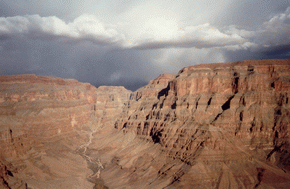AiG and the Grand
Canyon
John Stear (with a little
help from his friends!)

A side canyon on the north side of the Grand
Canyon
(Picture courtesy of Peter Barrett)
Answers in Genesis' (AiG's) weekly email newsletter once again ignores the massive amount of evidence refuting their belief in a world wide flood and a young Earth. They suggest that "many evolutionary geologists are now agreeing with us that it [the Grand Canyon] did not take millions of years to be carved!" Is it possible that this article, Is the Grand Canyon a Geologic Infant? on the University of Arizona website, is what AiG are referring to?
Unfortunately for AiG, these latest studies indicate that parts of the Grand Canyon may be only 600,000 to 700,000 years old. This remains orders of magnitude greater than the few thousand years required by YEC flood geology. If the age of the Grand Canyon was revised to around a thousandth of earlier estimates, creationists might be able to claim this as a victory. But since the new estimates are still over a hundred times what creationists want, they are just using the term "young" to mislead the gullible and the ignorant by dishonestly giving the impression that flood geology is somehow supported by the new research.
In their email newsletter AiG poses the question:Do Ph.D. scientists still agree on a slow and gradual formation of the Grand Canyon?
What a strange question. A Ph.D. could be obtained in any scientific discipline, perhaps not even relevant to geology so why does AiG place such emphasis on scientists holding Ph.Ds. AiG has a few Ph.D. accredited scientists on staff who see themselves as experts in any discipline they care to write about (is that why they get it wrong so often? For an example of scientific incompetence see Dr Jonathan Sarfati). Young Earth creationists (YECs) Andrew Snelling and Tasman Walker who have legitimate degrees in geology are eminently qualified to recognise the validity of a slow and gradual formation of the Grand Canyon. Sadly, they have forfeited their credibility as scientists because of their insistence on a literal Bible and what they call "Flood Geology", a theory unsupported by any evidence whatsoever.
YECs often claim that many "evolutionary" geologists agree with their young Earth claims and that the Grand Canyon and other geological features were formed as a result of Noah's flood. The problem is that they seldom name these "evolutionary" geologists who they claim are turning to creation "science". Who are these fickle scientists and where are the articles they are writing to support their change of views? AiG should be prepared to name the scientists and the magazines and journals their dissenting articles appear in. That they can't or won't do so suggests that most of these scientists exist only in the not so fertile imaginations of creationists.
For more information on the Grand Canyon see Grand Canyon: Some Links to Accurate Science.
The "Quotable Quote" AiG have included in their weekly email newsletter is, as in previous newsletters, clearly an attempt to undermine mainstream science in the eyes of their followers. They believe that because one branch of science comes up with new evidence that casts doubt on earlier findings, evolution must therefore be in doubt. What is really demonstrated in these instances is how science works, which is by testing explanations against observations and rejecting the ones that fail the test. In other words observations are supported, modified or replaced as new evidence appears. On the other hand, creationism is not science because creationists' theories are dependent on the Bible and cannot change regardless of the appearance of new evidence. In this instance Dr Tom Wilkie, a distinguished science editor, was writing in the Melbourne Age newspaper in 1991. It was April 1992 (after 1991) that irregularities in the distribution of the cosmic microwave background were detected and the findings announced. The best popular exposition of these results is "Wrinkles in Time" by George Smoot and Keay Davidson, published in 1994 which overtakes the survey Dr Wilkie wrote about in 1991.
More reviews of "Wrinkles in Time" can be found here.